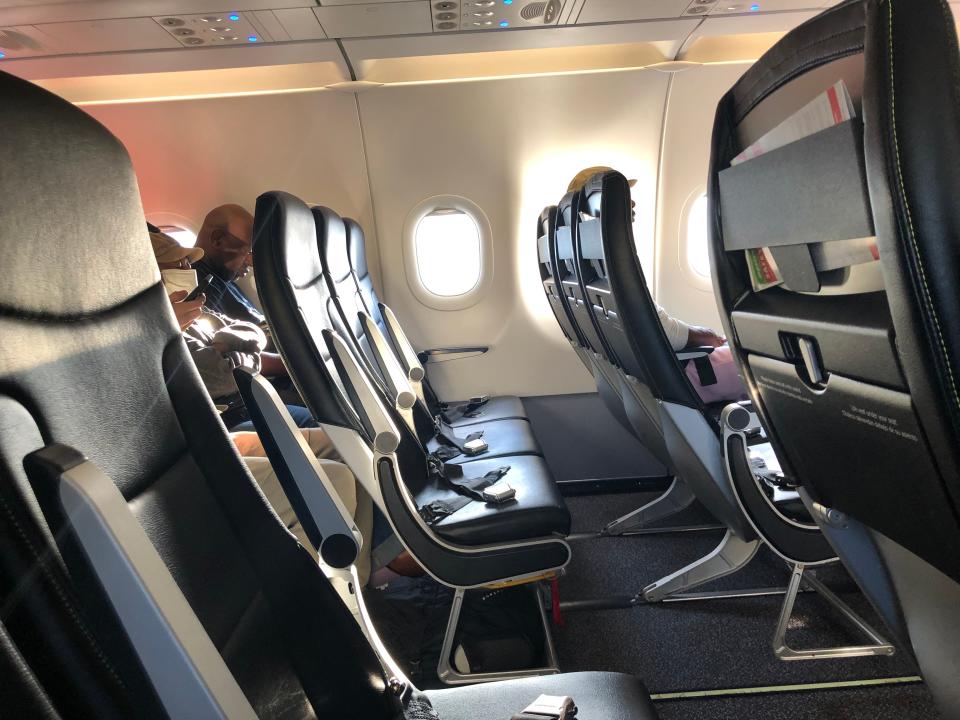Ding! Even if the seatbelt sign is off, you should stay buckled while flying. Here's why.
"Safety in Travel” is a six-part series focusing on the travel safety tools available in different industries, how they can affect the overall experience, and how travelers can make use of them. If you'd like to contribute to our future reporting and share your experience as a source, you can click here to fill out this quick form.
We've all heard it: the announcement on an airplane that even if the seatbelt sign is off, you should buckle up whenever you're seated.
According to experts, there's good reason for that guidance. Although flying is a safe way to travel, staying strapped in while you're in the air is a good idea because unexpected bumps are possible en route.
In the air, the seatbelts are there to keep you secure in the event of turbulence, not to keep you restrained in the event of a crash like in a car.
"If we were not flying a bunch of humans in this enclosed space with recirculated air miles above the earth, our preference would be that the seatbelt sign is on the entire time," Association of Flight Attendants president Sara Nelson told USA TODAY. "The pilots have the seatbelt sign on when they know we're at greatest risk for turbulence that can harm people, but we also have people who are traveling for hours at a time eating and drinking and there are human needs involved."
Tell us your story: Mobility device lost or damaged by an airline? USA TODAY wants to hear about it
Cruise medical facilities: What happens if you get sick or injured (or bitten by a monkey) on a cruise ship
Why should I keep my seatbelt on while flying?
According to Nelson, it's a good idea to stay buckled up whenever you're seated on a plane because it's always possible to encounter unexpected turbulence.
"While technology has improved, it is not 100% foolproof in detecting clear air turbulence," she said, referring to the bumps that can happen even outside of stormy conditions.
Brian Strzempkowski, interim director of the Center for Aviation Studies at The Ohio State University, agreed that turbulence can be hard to predict.
'Deeply sorry': Highlights from the Senate hearing over Southwest's holiday meltdown
"Turbulence can pop up anywhere. Oftentimes the pilot will say, 'we're not expecting any turbulence but just in case,' or 'we're expecting light turbulence, and this is why I'm turning the light on,' " he said. "You don't even need to have the seatbelt on snug and tight, just having it on loosely to give it a little restraint, if you hit a bump, you might move an inch or so, but it'll keep you from coming out of your seat and hitting your head."
In December, a Hawaiian Airlines flight from Phoenix to Honolulu encountered severe turbulence and 36 people onboard were injured. One passenger said she hit the ceiling of the cabin when she was unable to buckle her seatbelt.
How reliable is turbulence forecasting?
Strzempkowski told USA TODAY that turbulence is notoriously difficult to forecast.
"When you go onto the National Weather Service website, and you look up their aviation forecasts, they'll even tell you on there that these are not 100% accurate," he said, adding that turbulence in storms is a little more predictable than in places without bad weather. But, turbulence can happen anywhere, including over the ocean where air masses converge, or, commonly, over the Midwest as winds dissipate across the Rocky Mountains.

Is turbulence dangerous on airplanes?
Not if you're strapped in.
"If you are sitting there with your seatbelt on and you’re secured, there really is no risk. These planes are built strong enough that they’re able to withstand extremely bad turbulence," Strzempkowski said. "(Planes) all have to be able to withstand strong turbulence. ... I realize it’s uncomfortable for passengers, but the plane itself can handle it."
What does airplane mode do?: It's safer to have it on your phone when you fly, experts say
The bigger danger, Nelson said, is the possibility of getting injured in turbulence, not structural damage to the plane.
"The people who are not strapped in now also become projectiles themselves and can harm people when they come back down," she said. "I know plenty of flight attendants who have had career-ending injuries from turbulence."
Are there other risks while flying?
While turbulence is common on airplanes and can be dangerous when passengers aren't buckled up, it's not the only way someone can get injured in the air.
Nelson said it's not unusual for bags to fall out of overhead bins when they're opened, which is why announcements about being careful when retrieving your carry-on baggage are also common.
Inflation nation: Rising prices are affecting travel, but that doesn't mean it's slowing down
As the Federal Aviation Administration reauthorization looms in Congress, Nelson's organization is advocating for some new safety regulations as well, including setting minimum climate control standards for airplane cabins, and air quality monitoring systems that would alert flight attendants if any toxic chemicals get introduced into the air supply.
Overall, however, both Nelson and Strzempkowski emphasized that flying remains a very safe way to get around, especially when passengers are educated about how to mitigate risks onboard.
"Just follow the instructions of flight attendants," Nelson said, ending her interview with her top piece of perennial advice: "If there is an emergency evacuation, leave all bags behind."
Have you or someone you know experienced a dangerous situation during a flight?
This article originally appeared on USA TODAY: Safety tip: Stay buckled while flying to avoid injury in turbulence

